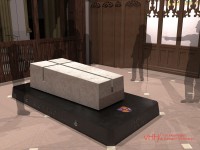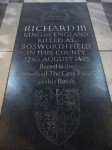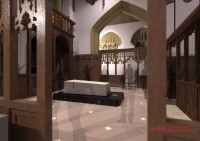 As there has been no appeal lodged to contest the ruling of the High Court that the remains of King Richard III are to be reinterred in Leicester Cathedral, plans for the reburial have been finalized. The Cathedral Fabrics Commission for England have approved the tomb design of architects van Heningen and Haward. There’s no inlaid marble white rose of York underneath the raised platform in this version. Instead, a plinth made of black Kilkenny marble will seal the tomb beneath the Cathedral floor. Richard’s name, dates and motto will be engraved into the sides of the plinth — the nature of the marble will make the lettering appear white in contrast with the dark color of the smooth surface — while his coat of arms is inlaid in marble and semi-precious hard stones at the top foot of the plinth.
As there has been no appeal lodged to contest the ruling of the High Court that the remains of King Richard III are to be reinterred in Leicester Cathedral, plans for the reburial have been finalized. The Cathedral Fabrics Commission for England have approved the tomb design of architects van Heningen and Haward. There’s no inlaid marble white rose of York underneath the raised platform in this version. Instead, a plinth made of black Kilkenny marble will seal the tomb beneath the Cathedral floor. Richard’s name, dates and motto will be engraved into the sides of the plinth — the nature of the marble will make the lettering appear white in contrast with the dark color of the smooth surface — while his coat of arms is inlaid in marble and semi-precious hard stones at the top foot of the plinth.
On top of the plinth will be a large rectangular block of Swaledale fossil stone, quarried in North Yorkshire, deeply incised with a cross along its full length and breadth. The fossil stone is so called because it is peppered with visible fossils, once-living beings long dead whose remains have been brought to light and immortalized in stone, a metaphorically significant analogy to Richard’s fate.
 Underneath the plinth, Richard’s remains will be laid to rest in a lead ossuary which will be placed in an oak coffin which in turn be placed in a brick lined vault under the Cathedral floor. The precise design of the wooden coffin is still being worked out and will be announced at a later date, but the carpenter who will make the coffin has been selected already. It’s Michael Ibsen, Richard’s sixteenth grand-nephew, a direct descendant down the maternal line of Richard’s sister Anne of York whose mitochondrial DNA helped identify the King’s remains. He’s a cabinet and furniture maker by trade, so it’s a fitting commission in every way. Ibsen accepted the work offer with alacrity, calling it “a very appropriate gift to offer to [his] royal ancestor.”
Underneath the plinth, Richard’s remains will be laid to rest in a lead ossuary which will be placed in an oak coffin which in turn be placed in a brick lined vault under the Cathedral floor. The precise design of the wooden coffin is still being worked out and will be announced at a later date, but the carpenter who will make the coffin has been selected already. It’s Michael Ibsen, Richard’s sixteenth grand-nephew, a direct descendant down the maternal line of Richard’s sister Anne of York whose mitochondrial DNA helped identify the King’s remains. He’s a cabinet and furniture maker by trade, so it’s a fitting commission in every way. Ibsen accepted the work offer with alacrity, calling it “a very appropriate gift to offer to [his] royal ancestor.”
The oak coffin will play an important role in the reburial ceremony. The ossuary will be placed in the coffin at the University of Leicester and the coffin will then be transported to the Cathedral along a public route that will follow what we know of King Richard’s movements on the last days of his life. It will be received formally by Cathedral officials accompanied by the medieval service of Compline. The coffin will then lie in state covered with a pall that will feature scenes from Richard’s life and death. The public will be invited to pay their respects at this time.
The reburial service will not be a funeral as Richard had one of those already. Instead it will be a special service designed according to detailed research of medieval reinterment rites (reburials were quite common back then, and there are extant sources describing the services). The service will conclude with the coffin being lowered into the brick vault. The tomb will be sealed overnight with the stone plinth and the sarcophagus-like Swaledale fossil stone marker.
 The tomb and marker will be installed in an ambulatory (an open walking space) between the new Chapel of Christ the King and the sanctuary under the tower, the most holy place in the Cathedral where the main altar stands. It will be a peaceful, quiet spot, separated from the main worship area of the Cathedral by the relocated Nicholson screen, an ornately carved screen created in the 1920s by ecclesiastical architect and baronet Sir Charles Nicholson to separate the nave from the chancel.
The tomb and marker will be installed in an ambulatory (an open walking space) between the new Chapel of Christ the King and the sanctuary under the tower, the most holy place in the Cathedral where the main altar stands. It will be a peaceful, quiet spot, separated from the main worship area of the Cathedral by the relocated Nicholson screen, an ornately carved screen created in the 1920s by ecclesiastical architect and baronet Sir Charles Nicholson to separate the nave from the chancel.
Cathedral officials hope to start the construction work this summer so the building can be finished by early 2015 in time for a Spring reburial. The total budget for this project is £2,500,000 ($4,240,000). The Diocese of Leicester will contribute £500,000 ($848,000) and £100,000 ($170,000) has already been collected in donations. Much of the rest will come from large grants from trusts, foundations and private donors. There will be a fundraising appeal later this year targeted to the Leicester community, giving local residents the opportunity to fund a specific element of the reburial project. Meanwhile, donations are open. If you’d like to contribute, you can do so online here or you can print out this pdf form for sending in a donation by mail.